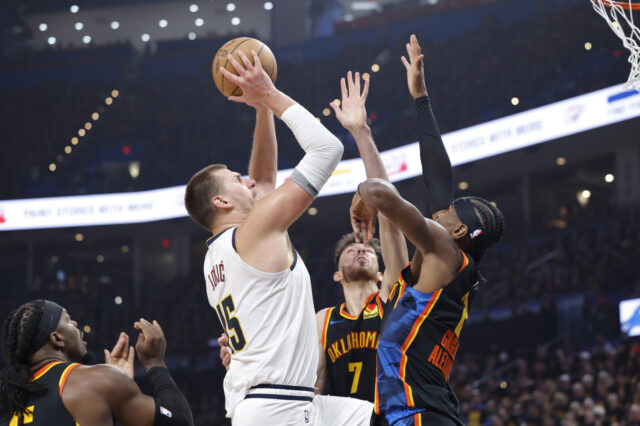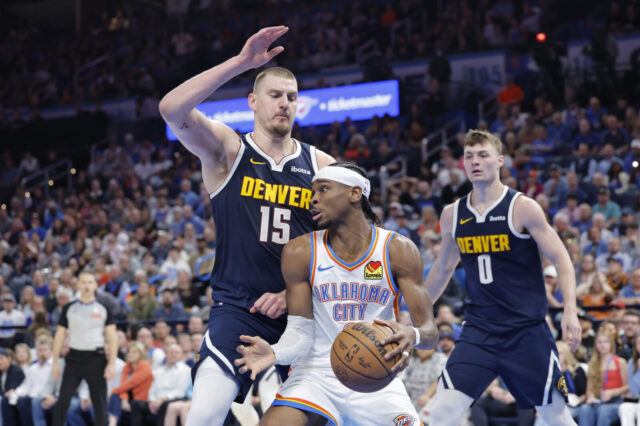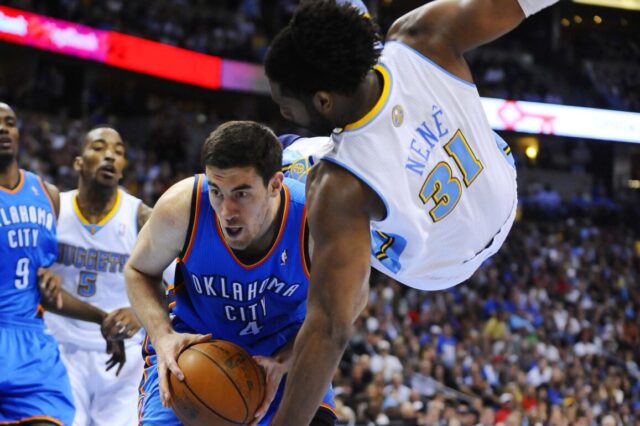Throughout the playoff series against the Portland Trail Blazers, Rodney Hood gave the Denver Nuggets all the trouble they could handle. Across seven games, Hood averaged 14.7 points per game (though it felt like at least 20 at the time) while maintaining 70.9% true shooting. He shot 50% from three-point range, went to the free throw line 31 times as the third scoring option, and gave the Blazers just enough in their wins to scrape past the Nuggets through six games and get to a Game 7.
Then, you know what happened in Game 7. The Nuggets lost a heartbreaker by four measly points, as Rodney Hood struggled but CJ McCollum shined, with Evan Turner coming off the bench and contributing 14 points and 7 rebounds in just 19 minutes. Paul Millsap struggled, and the Nuggets had no way to replace him in their rotation with Trey Lyles and Juancho Hernangomez on the outside of Michael Malone’s rotation (and deservedly so).
Nobody reading Denver Stiffs today needs a reminder of just how important a player like Jerami Grant would have been during the playoffs last year. A versatile, athletic forward with the size and agility to match a player like Hood or Turner step for step. If the Nuggets have Jerami Grant on their roster last season, they probably advance to the Western Conference Finals (at least).
But enough reflection on past seasons. The bubble question of the day is: can Jerami Grant be that difference maker this time around?
This content is no longer available.
When asked about Grant, Michael Malone described the athletic forward as one of the players Denver could certainly utilize more heavily against teams like the Los Angeles Lakers and Los Angeles Clippers.
When checking out the matchup data, that thought bears out. According to NBA.com’s matchup data, here’s how some of the NBA’s elite forwards have performed when guarded by Jerami Grant head-to-head this season:
- LeBron James: 4-of-7 FG, 8 points, 5 assists, 1 turnover
- Anthony Davis: 6-of-13 FG, 12 points, 1 assist, 2 turnovers
- Kawhi Leonard: 2-of-11 FG, 7 points, 3 assists, 2 turnovers
- Luka Doncic: 4-of-7 FG, 10 points, 2 assists, 3 turnovers
- Brandon Ingram: 3-of-12 FG, 7 points, 2 assists, 1 turnover
- Danilo Gallinari: 0-of-6 FG, 0 points, 0 assists, 3 turnovers
- Pascal Siakam: 4-of-8 FG, 10 points, 1 assist, 1 turnover
- Kevin Love: 8-of-13 FG, 19 points, 0 assists, 1 turnover
Some other matchups that had a much smaller sample size:
- Giannis Antetokounmpo: 2-of-6 FG, 6 points, 2 assists, 0 turnovers
- Paul George: 0-of-2 FG, 0 points, 1 assist, 0 turnovers
There are definitely some players that Grant struggled with, but the overall body of work matching up against elite talent was very solid. Grant always provides defensive intuition when matching up 1-on-1 on the perimeter against stars, and his physical abilities allow him to mirror and stay in front of his man.
Throughout the season, Grant also improved as a weak side help defender. His timing on block attempts at the rim improved by the day, and he made some impressive plays physically while covering for his teammates.
Nikola Jokic and Paul Millsap have developed great chemistry over the past three seasons, with Jokic becoming a primary playmaker and Millsap filling in the gaps around him. Rebounding, rim protection, outside shooting, and playing smart in off-ball sets on both ends of the floor have been part of Millsap’s game to game assignments. For the most part, this has worked well, and in the early part of this season, lineups with Millsap were wrecking opposing teams.
That changed a bit when Millsap sat out for several games due to injury and recovery.
This content is no longer available.
The sample wasn’t extensive, but in the games Millsap played after returning to the starting lineup, the singular defensive impact wasn’t quite as strong. The majority of Denver’s minutes with Millsap and Jokic together come in Denver’s starting lineup that also features Jamal Murray, Gary Harris, and Will Barton. That 5-man starting lineup was potent before Millsap’s injury (+12.1 Net Rating before 1/7) and unremarkable when he returned (-8.2 Net Rating after 2/8).
Millsap was not the only factor in this lineup, but he was one factor. The defense wasn’t as potent, and Denver’s stars have actually struggled mightily from behind the three-point line with the starting unit. Jokic shot 19 or 75 from three (25.8%) and Murray shot 33 of 116 (28.4%) with Harris, Barton, and Millsap also on the floor. Given the starting lineup has played more minutes together than any lineup in the NBA, it’s hard to consider abnormal numbers just noise in that scenario.
This is where Jerami Grant comes in. Offensively, Grant’s impact on the shooting percentages for his teammates is stark. With Grant on the floor, the Nuggets shot 37.8% from three this season, the highest mark in the rotation. With Grant off the floor, the Nuggets shot 33.5% from three, the lowest mark in the rotation. Some of this variance is about Grant’s own individual shooting, and it definitely helps to be shooting 40% from three.
But the simple ability to space the floor, cut quickly, and be a threat defenses have to worry about always helps out the rest of the team.
When opposing defenses aren’t worried about the supporting cast, covering the initial actions an offense wants to run becomes a little bit easier. The Nuggets often run the Jokic-Murray two-man game when they need a basket, and often, when the opposing team can only use the two primary defenders to guard said action, Jokic and Murray generally do well.
Below is an example of Barton and Jokic closing out a game against Shabazz Napier and Karl-Anthony Towns with oodles of space to work with at the top of the key. Notice how Monte Morris, Michael Porter Jr., and Grant are all on the floor as quality floor spacing threats?
Having that extra space in a playoff series alleviates some pressure on star players to do what they’re generally asked to do: score and create for others. Jokic operates well when he’s given room to see the floor and make decisions that way. Murray is the same way, often finding open midrange jumpers or stepping back all the way to three-point territory.
Denver’s biggest problem in the playoffs last season wasn’t defending Rodney Hood. It was the floor spacing disappearing in the Jokic-Murray two-man game. Outside of Jokic and Murray, the Nuggets shot 30.1% from three against the Blazers which just won’t get it done this year against some of the elite offenses getting ready to suit up. Having players on the floor the Nuggets can trust to space it adequately and hit the threes they need to hit is a big deal. Not only has Grant proven he can do that this season, but he also shot well from the playoffs last year in Oklahoma City’s playoff loss to the Blazers while Grant was still with the Thunder.
The 3-and-D player archetype in basketball is definitely overrated, given the actual impact that type of player has on the game without doing other stuff; however, surrounding the Murray-Jokic two-man game with players that fit the 3-and-D style will help the Nuggets in the biggest way. Those two have proven capable of impacting a playoff series and doing most of the heavy lifting on their own. Where they need help is on the margins: a defensive stop against a star, an extra made basket in a key moment, or a clutch play in transition where the athletes generally thrive.
Jerami Grant is as great an option as any to be that missing piece. When the Nuggets were missing another body to play the forward position last year in Game 7 with Paul Millsap having fouled out, Grant would have been a great option. If the Nuggets need to throw another defender at Kawhi Leonard and stick with one of the best players in the world, Grant can be that option.
I’m looking forward to seeing what the Nuggets end up looking like in a playoff setting this year, and my sneaking suspicion is that Jerami Grant will be more important and play a lot more than people realize.


